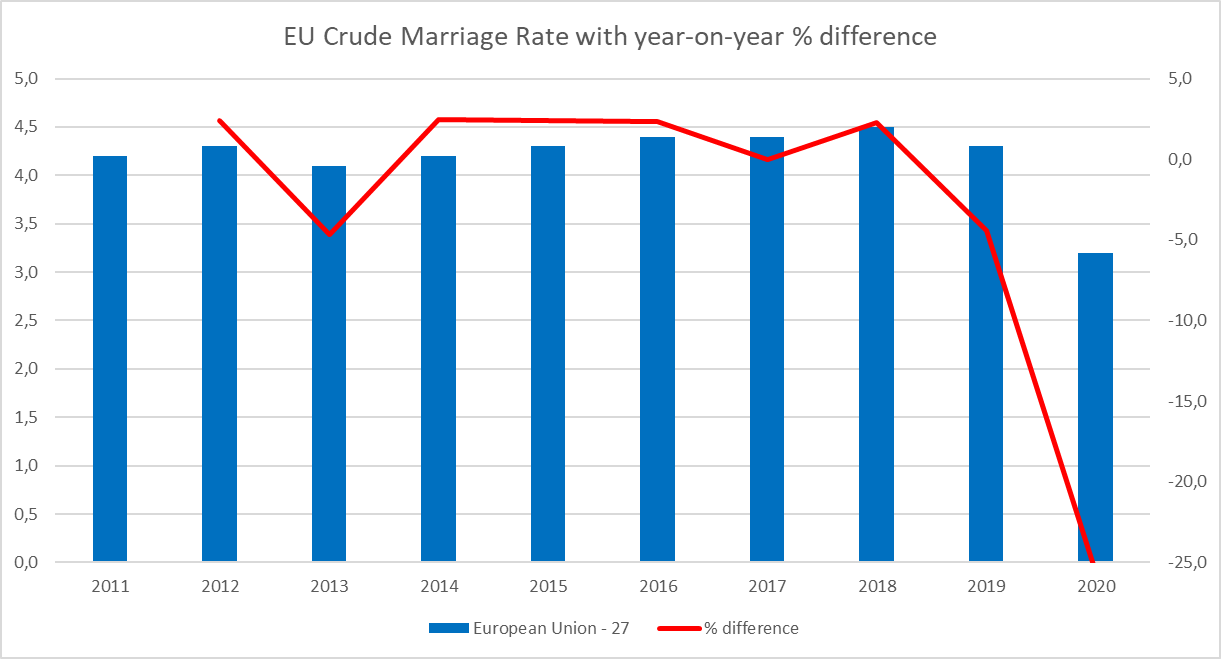I’ve been thinking some more about the 4 main criticisms or objections that have been raised toward my pandemic Wedding Crasher hypothesis explaining the crash in births.
Objection 1: Marriages don’t lead to births!
Of course, not all marriages lead to births, and I recognise not all births are to married mothers. However, the data is very clear that substantial proportions of births are still to married mothers. The actual percentage varies by culture and country. The following is taken from an OECD document (updated Sept. 2020) on the share of births outside of marriage:
It stands to reason that if marriages crash and ~60% of births are within marriages there must be an effect on births. Sure, couples could still have started families in the pandemic despite their postponed or cancelled wedding but this is often such a strong cultural phenomenon that I do not expect couples to change their attitude towards it so suddenly.
Conclusion: If there is a sudden significant fall in marriages, this will also be seen in births data - the critical factor is when.
Objection 2: Falls in births are too exceptional!
In some of the analyses being done by other substackers they point to the exceptional nature of the drops in births for Q1 2022. I contend the drops in marriage rates in 2020 (starting in Q2) are just as exceptional. Using the same crude marriage rate data from my first Wedding Crasher post I have calculated the % falls for the different countries in Europe. The EU-wide average (using available data) is over 25% while some of the individual decreases are huge!
In case it is not obvious how exceptional this is, I have plotted the EU average for the past 10 years 2011-2020 with the year-on-year percentage difference:
And just so we are doubly clear, although Eurostat does not provide data for 2021 marriage rates, individual country data, for example from Germany, Sweden and others, shows marriage rates barely recovered in the second pandemic year.
Conclusion: the crash in marriages during two pandemic years is as exceptional as the crash in births happening in 2022.
Objection 3: Why do births suddenly crash in Q1 2022?
This is the strongest criticism of my hypothesis and in my post about Why is there a sudden drop in German births I go into some detail on this. My contention is that births did not crash in 2021 because:
(i) 2021 births were to pre-existing established couples (married or not) who decided in 2020 to extended or start their families. For example, this graphic for German births in 2021 shows their mini baby boom was disproportionately driven by people extending their familes.
(ii) most married couples simply don’t produce births 9 months later. It normally takes much longer. If couples on average first conceive a year after marriage this would correspond with births 21-24 months after marriage - so “missing marriages” from Q2 & Q3 in the first pandemic year would result in “missing babies” in Q1 & Q2 2022.
Unfortunately, I have not found usable data on the average interval between marriage and first births (there is lots of data for the interval after first, second, third births, etc., but not on interval after marriage). The data I have found suggests the average interval varies by age at marriage but also by culture/country.
This is certainly the weakest part of my hypothesis. The correlation between the magnitude of the disruptions to marriages and births is strong but the explanation of the timing is not yet supported by data.
Objection 4: What about Hungary!
Hugary’s marriages did not fall in the first pandemic year and yet their births also dropped sharply in Q1 2022 - doesn’t this disprove my hypothesis? That marriages fell all over Europe except in Hungary (where they grew) is very unusual. After some researching, it turns out Hungary started a state financial incentive scheme in 2019 with state subsidies to encourage more marriages and births. Marriages shot up in 2019 and remained high in the first pandemic year. In my opinion, Hungary is an absolute outlier and it’s inflated marriage figures may not accurately reflect real numbers of couples marrying to start a family but perhaps a lot of couples getting married to avail of state subsidies.
Summary: The weakest link is the timing, i.e. explaining the sudden onset of the drop in births in Q1 2022. I feel the other main objections can be explained by the data.
Hypothesis: Analysis of the 2022 births by birth order should show a disproportionate fall in first births (those most likely to ensue from (first) marriages). This would support the crash in marriages as opposed to the vaccination campaign.
If births fell uniformly across the birth order (1st, 2nd, 3rd births etc.) then that would point me back to a disruption in conceptions in Q2 2021. Any issue with miscarriages should have shown up in the live births and stillborn data during Q2 - Q4 2021.
As ever, I appreciate any feedback in trying to figure the riddle out.








Extra like for ending the post with a prediction/testable hypothesis.